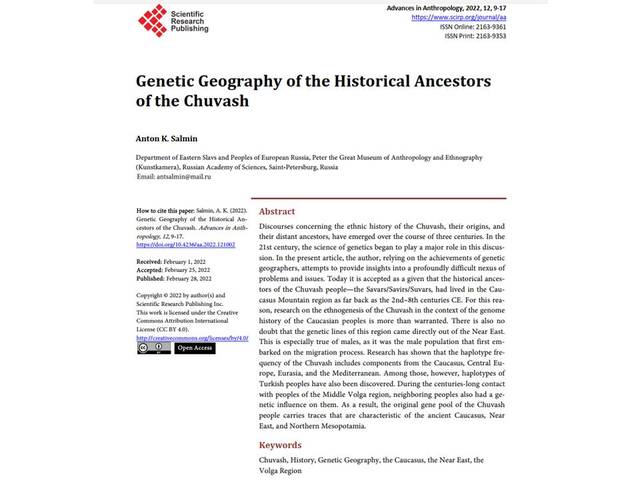Salmin A. K. Genetic Geography of the Historical Ancestors of the Chuvash // Advances in Anthropology. 2022. No 12: 9-17.

Salmin A. K. Genetic Geography of the Historical Ancestors of the Chuvash // Advances in Anthropology. 2022. No 12: 9-17.
Abstract
Discourses concerning the ethnic history of the Chuvash, their origins, and their distant ancestors, have emerged over the course of three centuries. In the 21st century, the science of genetics began to play a major role in this discussion. In the present article, the author, relying on the achievements of genetic geographers, attempts to provide insights into a profoundly difficult nexus of problems and issues. Today it is accepted as a given that the historical ancestors of the Chuvash people—the Savars/Savirs/Suvars, had lived in the Caucasus Mountain region as far back as the 2nd–8th centuries CE. For this reason, research on the ethnogenesis of the Chuvash in the context of the genome history of the Caucasian peoples is more than warranted. There is also no doubt that the genetic lines of this region came directly out of the Near East. This is especially true of males, as it was the male population that first embarked on the migration process. Research has shown that the haplotype frequency of the Chuvash includes components from the Caucasus, Central Europe, Eurasia, and the Mediterranean. Among those, however, haplotypes of Turkish peoples have also been discovered. During the centuries-long contact with peoples of the Middle Volga region, neighboring peoples also had a genetic influence on them. As a result, the original gene pool of the Chuvash people carries traces that are characteristic of the ancient Caucasus, Near East, and Northern Mesopotamia.
Keywords
Chuvash, History, Genetic Geography, the Caucasus, the Near East, the Volga Region
